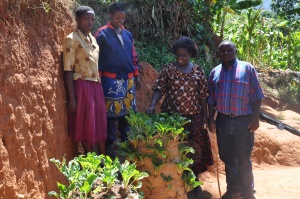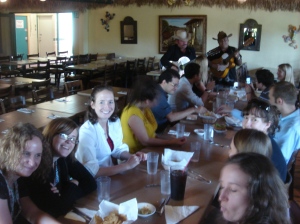, an online sustainable living resource. The Executive Director of
, Scott Sabin, blogs here monthly on environmental, social justice, and poverty issues. Enjoy!
Finding Beauty on the Border
By Scott Sabin
During a recent trip to the Dominican Republic, I caught a glimpse of what the island must have looked like a few centuries ago. Driving through the steep mountains in Sierra de Neiba National Park near the Haitian border was like stepping back in time.

As our group’s two pickups struggled through the grass and rocks that covered the road, it was clear that we were the first vehicles to pass this way in at least a few days.
To our right, branches festooned with reddish bromeliads shaded our path, while a thin mist drifted through the trees and obscured the tops of the mountain. To our left, a vertigo-inducing drop off into thin air, the valleys of Haiti visible far in the distance. Perched high on the mountaintop, overlooking the valley, I was stunned by the breathtaking beauty.
Driving through this forest, it is easy to imagine how things were meant to be in the Garden. We can only speculate what Creation in a pre-Fall world must have been like, yet for all that has been tainted because of all that human sin has done to degrade it, the beauty of what God has made shines through even the most unlikely places. Whatever has changed, God’s ability to work things together for good is apparent in the intricate ways that ecosystems like this fit together so perfectly. Nothing is wasted and everything has its niche. Everywhere, life springs forth from death and resurrection is foreshadowed.
However, all too soon our pick ups drop out of the trees and back into reality. The view is still spectacular, but now there is much that is clearly broken. On one side of the gorge, huge eroded hillsides bisect the bean fields which blanket all but the steepest of impossibly steep slopes. The other side, above the flood-scarred dry wash which marks the border, raw rock shows through everywhere and dozens of Haitian homesteads dot the hillsides. Every available inch shows an attempt at cultivation, no matter how apparently futile. The first village we come to, a collection of wooden shacks, a one room school and a military border checkpoint, has been nicknamed “The Armpit.”

But even here, there is hope. There is Good News and there are options. The people may be disempowered, but they are not helpless, even if they feel that way. Perhaps they just need to be reminded of their own God-given talents. Like all of us, they need to be reminded of their own importance in the eyes of God and of the love He has for them.
In the few years that Plant With Purpose has been working in this area we have begun to see growth as individuals and communities begin to use their God-given potential. We have seen people’s lives transform from poverty and misery into hope. Hills that were left barren by slash and burn agriculture are now covered with crops.
For example, in Angel Feliz, a small village near the Haitian border, we visited one farmer named Florido. During our visit, he eagerly zig-zagged up and down the steep hillside, pointing out blooming vegetation here and there as we scrambled after him, gingerly stepping in between cabbage and celery plants in our clunky hiking boots. He proudly told us how last December he made $1,000 by selling Christmas cabbage, and he anticipates that this year will be no different. In a place where the land and weather can be extremely volatile, this is indeed good news.
Florido’s story, like those of so many other Dominican farmers, is one of hope and prosperity. As we look to the future, we pray that, as in other areas where we have worked, people’s relationships with God, neighbors and the land will be transformed. When that occurs, we see glimpses of the Kingdom - the final restoration of the land and its people. In those glimpses there is tremendous beauty.
 Congratulations to Amanda Benavides for recruiting 30 people to the Plant With Purpose facebook cause! Since this is the most people recruited by one person, Amanda will receive a $100 gift card! Way to go Amanda, and thanks for helping us spread the word about Plant With Purpose.
P.S. Even though the contest has ended, you can still encourage your friends to join our cause and help advocate to reverse the vicious cycle of poverty in the lives of the rural poor. Click here to join our facebook cause!
Congratulations to Amanda Benavides for recruiting 30 people to the Plant With Purpose facebook cause! Since this is the most people recruited by one person, Amanda will receive a $100 gift card! Way to go Amanda, and thanks for helping us spread the word about Plant With Purpose.
P.S. Even though the contest has ended, you can still encourage your friends to join our cause and help advocate to reverse the vicious cycle of poverty in the lives of the rural poor. Click here to join our facebook cause!
 As our group’s two pickups struggled through the grass and rocks that covered the road, it was clear that we were the first vehicles to pass this way in at least a few days.
To our right, branches festooned with reddish bromeliads shaded our path, while a thin mist drifted through the trees and obscured the tops of the mountain. To our left, a vertigo-inducing drop off into thin air, the valleys of Haiti visible far in the distance. Perched high on the mountaintop, overlooking the valley, I was stunned by the breathtaking beauty.
Driving through this forest, it is easy to imagine how things were meant to be in the Garden. We can only speculate what Creation in a pre-Fall world must have been like, yet for all that has been tainted because of all that human sin has done to degrade it, the beauty of what God has made shines through even the most unlikely places. Whatever has changed, God’s ability to work things together for good is apparent in the intricate ways that ecosystems like this fit together so perfectly. Nothing is wasted and everything has its niche. Everywhere, life springs forth from death and resurrection is foreshadowed.
However, all too soon our pick ups drop out of the trees and back into reality. The view is still spectacular, but now there is much that is clearly broken. On one side of the gorge, huge eroded hillsides bisect the bean fields which blanket all but the steepest of impossibly steep slopes. The other side, above the flood-scarred dry wash which marks the border, raw rock shows through everywhere and dozens of Haitian homesteads dot the hillsides. Every available inch shows an attempt at cultivation, no matter how apparently futile. The first village we come to, a collection of wooden shacks, a one room school and a military border checkpoint, has been nicknamed “The Armpit.”
As our group’s two pickups struggled through the grass and rocks that covered the road, it was clear that we were the first vehicles to pass this way in at least a few days.
To our right, branches festooned with reddish bromeliads shaded our path, while a thin mist drifted through the trees and obscured the tops of the mountain. To our left, a vertigo-inducing drop off into thin air, the valleys of Haiti visible far in the distance. Perched high on the mountaintop, overlooking the valley, I was stunned by the breathtaking beauty.
Driving through this forest, it is easy to imagine how things were meant to be in the Garden. We can only speculate what Creation in a pre-Fall world must have been like, yet for all that has been tainted because of all that human sin has done to degrade it, the beauty of what God has made shines through even the most unlikely places. Whatever has changed, God’s ability to work things together for good is apparent in the intricate ways that ecosystems like this fit together so perfectly. Nothing is wasted and everything has its niche. Everywhere, life springs forth from death and resurrection is foreshadowed.
However, all too soon our pick ups drop out of the trees and back into reality. The view is still spectacular, but now there is much that is clearly broken. On one side of the gorge, huge eroded hillsides bisect the bean fields which blanket all but the steepest of impossibly steep slopes. The other side, above the flood-scarred dry wash which marks the border, raw rock shows through everywhere and dozens of Haitian homesteads dot the hillsides. Every available inch shows an attempt at cultivation, no matter how apparently futile. The first village we come to, a collection of wooden shacks, a one room school and a military border checkpoint, has been nicknamed “The Armpit.”
 But even here, there is hope. There is Good News and there are options. The people may be disempowered, but they are not helpless, even if they feel that way. Perhaps they just need to be reminded of their own God-given talents. Like all of us, they need to be reminded of their own importance in the eyes of God and of the love He has for them.
In the few years that Plant With Purpose has been working in this area we have begun to see growth as individuals and communities begin to use their God-given potential. We have seen people’s lives transform from poverty and misery into hope. Hills that were left barren by slash and burn agriculture are now covered with crops.
For example, in Angel Feliz, a small village near the Haitian border, we visited one farmer named Florido. During our visit, he eagerly zig-zagged up and down the steep hillside, pointing out blooming vegetation here and there as we scrambled after him, gingerly stepping in between cabbage and celery plants in our clunky hiking boots. He proudly told us how last December he made $1,000 by selling Christmas cabbage, and he anticipates that this year will be no different. In a place where the land and weather can be extremely volatile, this is indeed good news.
Florido’s story, like those of so many other Dominican farmers, is one of hope and prosperity. As we look to the future, we pray that, as in other areas where we have worked, people’s relationships with God, neighbors and the land will be transformed. When that occurs, we see glimpses of the Kingdom - the final restoration of the land and its people. In those glimpses there is tremendous beauty.
But even here, there is hope. There is Good News and there are options. The people may be disempowered, but they are not helpless, even if they feel that way. Perhaps they just need to be reminded of their own God-given talents. Like all of us, they need to be reminded of their own importance in the eyes of God and of the love He has for them.
In the few years that Plant With Purpose has been working in this area we have begun to see growth as individuals and communities begin to use their God-given potential. We have seen people’s lives transform from poverty and misery into hope. Hills that were left barren by slash and burn agriculture are now covered with crops.
For example, in Angel Feliz, a small village near the Haitian border, we visited one farmer named Florido. During our visit, he eagerly zig-zagged up and down the steep hillside, pointing out blooming vegetation here and there as we scrambled after him, gingerly stepping in between cabbage and celery plants in our clunky hiking boots. He proudly told us how last December he made $1,000 by selling Christmas cabbage, and he anticipates that this year will be no different. In a place where the land and weather can be extremely volatile, this is indeed good news.
Florido’s story, like those of so many other Dominican farmers, is one of hope and prosperity. As we look to the future, we pray that, as in other areas where we have worked, people’s relationships with God, neighbors and the land will be transformed. When that occurs, we see glimpses of the Kingdom - the final restoration of the land and its people. In those glimpses there is tremendous beauty.






















